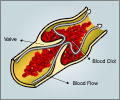A study found women who sit for long periods of time everyday are two to three times more likely to develop a life-threatening blood clot in their lungs than more active women.

An editorial published alongside the study says that, although the risk is small – equivalent to seven extra cases per 10,000 person years, and only slightly higher than seen in users of oral contraceptives or long haul airplane travel - the findings could have major health ramifications.
Pulmonary embolism develops when part, or all, of the blood clot travels through the bloodstream from the deep veins in the leg and up into the lungs. Symptoms include difficulty breathing, chest pain and coughing.
While other studies have explored the relationship between physical activity and pulmonary embolism, few data are available linking the condition with physical inactivity.
Dr Christopher Kabrhel and colleagues studied 69,950 female nurses over an 18-year period providing detailed information about their lifestyle habits by completing biennial questionnaires.
They found that the risk of pulmonary embolism is more than two times higher in women who spend most time sitting (more than 41 hours a week outside of work) compared with those who spend least time sitting (less than 10 hours a week outside of work).
Advertisement
The study also shows that physical inactivity correlated with heart disease and hypertension and could be one of the hidden mechanisms that link arterial disease and venous disease.
Advertisement
In the accompanying editorial, researchers in Canada say the study "reinforces the notion that prolonged inactivity increases the risk of venous thromboembolism, and it shows how this occurs in everyday life." The findings also indirectly support the use of preventive interventions for at risk people with prolonged immobility, they conclude.
Source-Eurekalert














